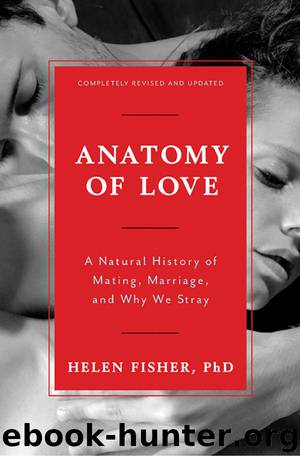Anatomy of Love: A Natural History of Mating, Marriage, and Why We Stray (Completely Revised and Updated) by Helen Fisher

Author:Helen Fisher
Language: eng
Format: mobi
ISBN: 9780393285222
Publisher: W. W. Norton & Company
Published: 2016-02-02T00:00:00+00:00
Brotherly Love
As the brain expanded and women began to bear helpless young with a long teenage, pressures on parents must have mounted—stimulating the evolution of another human hallmark: our formal human kinship systems.
Many animals, including all of the higher primates, tend to hang around with mother, are highly familiar with their siblings, and have specific relationships with all the other members of the group. The informal roots of human kinship lie deep in our mammalian past. But when our ancestors began to develop categories of relatives, each with prescribed ties and duties, they had begun to build the social glue of traditional human social life.
The evolution of our human kinship systems is among the oldest arguments in anthropology. Basic to the debate has been the question, which came first: matriliny (tracing your lineage through your mother’s line) or patriliny (tracing your lineage through your father’s line)? Today many tribal peoples, as well as many contemporary postindustrial peoples, trace their descent through both their mothers’ and fathers’ lines, a bilateral kinship system. But this kin structure is not generally found in nature. So, our Homo erectus forebears most likely grew up with either their mother’s or their father’s blood relatives and others who joined the community.
Primitive matriliny or patriliny? The lives of our close relatives give conflicting clues.
Among savanna baboons, groups of related females travel as a unit, whereas males depart for other troops as they mature—the kernel of matriliny, the kinship system based on female genetic ties.
Among common chimpanzees the reverse is true. Related males tend to remain together to defend their community, whereas females typically leave the group at puberty to seek mates in neighboring groups. Here are the seeds of patriliny, the kinship system based on male blood ties. Interestingly, an ingenious study of fossils (dating from more than two million years ago) suggests that females dispersed farther than males,24 perhaps to join novel partners in a different group, a sign suggesting primordial patriliny.
But in most of today’s hunting-gathering societies, both young men and young women are free to leave or remain in their natal group; moreover, when they marry, a couple may live with either the husband’s or the wife’s kin. Indeed, they often live with both kin groups, switching their residence when they choose.25 Yet some hunter-gatherers trace their descent through mother; some hark to their father’s line; and some regard themselves of members of both kin groups simultaneously—a bilateral kinship system.26
Because kinship structure varies among primates, including humans, it is impossible to make an informed guess about the kin networks of these early Homo erectus bands. With a few exceptions: almost certainly all members knew one another and could recognize “mother.” With the evolution of pair-bonding, they must have also included in their inner circle mother’s “special friend.”
Then at some point, they began to expand this network to include mother’s or father’s genetic relatives and their relatives’ special friends—affinal relatives related only by “marriage.” Hence they began to convert these biologically unrelated men and women into family members.
Download
This site does not store any files on its server. We only index and link to content provided by other sites. Please contact the content providers to delete copyright contents if any and email us, we'll remove relevant links or contents immediately.
The 5 Love Languages: The Secret to Love That Lasts by Gary Chapman(9588)
Doing It: Let's Talk About Sex... by Hannah Witton(9187)
Should I Stay or Should I Go? by Ramani Durvasula(7562)
The Road Less Traveled by M. Scott Peck(7522)
The Lost Art of Listening by Michael P. Nichols(7406)
Daring Greatly by Brene Brown(6444)
Beartown by Fredrik Backman(5596)
We Need to Talk by Celeste Headlee(5542)
Men In Love by Nancy Friday(5155)
The Rules Do Not Apply by Ariel Levy(4861)
The State of Affairs by Esther Perel(4639)
How To Win Friends and Influence People by Dale Carnegie(4443)
Reflections Of A Man by Mr. Amari Soul(4237)
Pillow Thoughts by Courtney Peppernell(4208)
The Ethical Slut by Janet W. Hardy(4173)
Algedonic by r.h. Sin(4011)
He's Just Not That Into You by Greg Behrendt & Liz Tuccillo(3831)
I Love You But I Don't Trust You by Mira Kirshenbaum(3805)
Surrounded by Idiots by Thomas Erikson(3773)
